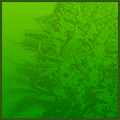|
We Update Daily!
 Custom Search Custom Search
Chris S. Kenoyer. Owner
MMJ Patient, Medical Activist,
Online Patients Advocate,
Online MMJ News Journalist
My Medical Bio
Follow Us Now On Twitter
@MedicalMMJMan
Or Follow Us Now
On Facebook
Email Us Here
olpwebs@yahoo.com
Or Email Us Securely Here
MedicalMMJMan@countermail.com
NEW 100% Encrypted Email Server
OLP’s Free MMJ News EList
Get The Latest In MMJ News
Press Contact Info
Is CBD? A Possible Cure For
Breast Cancer..? And All The Other
Many Forms & Types Of Cancer..?
Learn More About CBD Here
***************************
Advertise Here On OnlinePot
Rates As Low As $50 a Year
24/7 – 365 Days A Year Of Sales!
***********************************
Website Navigational Links
Main Start Page 2
**************************
Latest Marijuana News Reports
*********************************
Parody’s Cartoons US
Government Grown Pot,
Term Papers, School
Reports, & Thesis’s On
Marijuana & Cannabis
*********************************
Amsterdam A to Z
********************************
Canadian Marijuana Websites
*******************************
Church’s & Pot Cannabis
*****************************
Co-Ops, Clinics, Dispensary’s
*****************************
Marijuana Doctors & Clinics
****************************
Pot Cooking Recipes
****************************
Drug Testing A To Z
***************************
Pot Games
****************************
Pot Songs Video’s
****************************
100’s Of Grow Guides
***************************
Hash A- Z
***************************
Cannabis Legal Info, Drug
Lawyers, State, Federal Laws,
State & Supreme Court Rulings
**********************
POW’s Of The MMJ War!
*****************************
Other Marijuana Websites
Reciprocal Link Exchange
****************************
Medical Marijuana Studies,
Research Report’s, Medical
Cannabis Clinic Study’s
****************************
Parody’s & Cartoons
When We All Need A Good Laugh!
****************************
Avoiding Online MOM Scammers
Newly Re-Updated Info!
*****************************
The Politics Of Contraband
Medical Marijuana In The Mail?
******************************
The Hall Of Shame Section
The Online MOM Scammers
*****************************
Online MOM Providers Ads
****************************
Politicians & Voters Rights
****************************
Medical Marijuana, Strains
****************************
The OG Marijuana Strain Guide
****************************
800+ FAQ Growing Questions
****************************
Patients Spiritual Guidance,
Free Online Crisis Help Center
****************************
Online Marijuana Seed Banks
****************************
Maximum Security Section
Just Updated!
*****************************
Traveling Tips, Guides, B & B’s
****************************
Vaporizers A To Z
*****************************
Online Pot Video’s & Movies
**********************************************
Please Visit Both Of Our Sister Websites!
Maine Patients Coalition.org
The Reefer Madness Teaching Museum.org
Listen Right Here Online!
To Original 1930-1950’s
Reefer Madness Propaganda
Radio Shows And Programs
Before TV There Were
"Radio Stars"



*********************************
Legal Disclaimer
Guest Book
Translate Text or Web Page Go To:
Language Tools Google Translations
Article Submissions & News
Reports Are Always Gladly
Accepted Here.

No part of this site maybe used or
reproduced in whole or in part
without the written consent of the
Copyright Owner
www.onlinepot.org
OLP ENTERPRISES L3C
1999-2014 Copyright
© All rights reserved
OnlinePot assumes no legal liability for any products, or information or
news posted, services offered, Or
any contests or give away’s offered.
|
|
Rockwool The Book Chapter # 4
Grow Lights
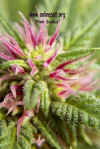
Pink Indica Bud
Rockwool the Book Chapter #1
Learn how to grow medical marijuana hydroponicly,
all 8 chapters ONLINE!
Rockwool #2 Physiology of Plants
Rockwool #3 Necessities and Climate Control
Rockwool chapter #4 Lights
Rockwool #5 Lights,CO2,Climate,Humidity
Rockwool #6 Water
Rockwool #7 Growing Cannabis
Rockwool #8 Diseases, Pests,& Plagues
Chapter 4: Light
4.1. Preface
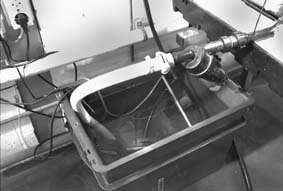
watertank with the needed accesories
Plant growth involves the conversion of light energy into plant-building materials (photosynthesis, see chapter 2). Two factors are important for optimal growth. In the first place, the light intensity. Light intensity is expressed in ‘lumens’. At least 50,000 lumens are needed for growing indoors. It’s not sufficient to add up the number of lumens listed by the manufacturer for each lamp. The total number of lumens given off is depends strongly upon good reflection, and proper connecting fixtures and starter ballasts for the lamps. The quality of the reflector used, and the connecting fixtures and ballasts determine the light yield for the greatest extent. For those reasons, self-built sets and home-designed illumination often deliver a lot less light yield than lamps being used in professional horticulture. We can improve the light yield in our grow room by applying reflective material. We haven’t painted the walls of the room matt white, and used reflector caps for the lamps for nothing! The second important factor is the wavelength of the light. For the production of chlorophyll, and an optimum photosynthetic reaction, light from the blue spectrum (445 nanometers), and light from the red spectrum (650 nanometers) is necessary. Blue light ensures optimal phototropism. Phototropism is the phenomenon which causes plants to grow towards the light, and to spread their leaves in such a way to receive the most light.
4.2. Choices for lamps
In this book, we prefer high-pressure sodium lamps, and mercury-iodide lamps for illumination. Ordinary light bulbs are not suited for cannabis-growing due to their considerably short life span, and principally due to their low light yield. Halogen lamps are not advisable for the same reasons. Fluorescent lamps are not appropriate for home growing. They do serve well, however, to stimulate seedlings and cuttings to set root. For actual growing, we stick to gas discharge lamps in the form of high-pressure- sodium, and mercury-iodide lamps. There are lamps being sold which emit both the wavelengths needed (blue and red) but we prefer installing seperate lamps in a 1:3 proportion (1 lamp for blue light with 3 for red light). The combination lamps give off a lower amount of lumens, since they have to emit different wavelengths. This counts for growing: the more lumens, the greater the yield. This doesn’t mean we can install an unlimited number of lamps. Other factors must be considered. Using many lamps means a higher temperature (the heat must be discharged of), a greater need for fresh air (containing CO2), and a greater need for water and feeding. Always remember the law of minimums Depending on the size of the garden, we use 400 Watt lamps or 600 Watt lamps. This choice is made in such a way that all the plants in the garden area can be illuminated as evenly as possible. By using 400 W lamps, you can put up one-and-a-half times as many lamps for the same electricity use as when using 600 watt lamps.Also 1000 watt lamps are being sold but proper reflectors for these types of lamps are not available. The result is a disproportionately large loss of yield. Moreover, 1000 Watt lamps give off more heat. Therefor they must be hung high above the plants, and this means more loss of light yield plays in the question. 1000 Watt lamps, with respect to 400 and 600 Watt lamps, mostly cause pain in your wallet, because the electricity bill gets higher.
In practice, it is possible to reach a light yield of 70-90% of the lumens which are emitted. For that, (it can’t be stressed enough), good reflection is necessary. Below is a chart with data for several reflective materials: Reflectivity in % – Reflective plastic sheet 90-95 – matt white paint 85-90 – semi-matt white paint 75-80 – matt yellow paint 70-80 – Aluminium foil 70-75 – Black paint less than 10 Using proper reflective material, proper connecting fixtures ballast equipment, proper reflector caps with the lamps, and a distance from the lamps to the plants of 40 to 60 centimeters, 400 Watt lamps deliver, on average, between 35,000 and 47,500 lumens, and 600 Watt lamps between 60,000 and 80,000 lumens (at a distance of 50-70 centimeters). The distance between the plants and the lamps differs because 600 W lamps give off more heat. Ifthe plants are to close to the lamps, they will dry out and burn 600 Watt lamps are preferred, because you get the highest light yield for the lowest electricity cost. Though they do require more careful climate control The life span of a high-pressure gas lamp is approximately 2 years when it’s used 18 hours a day. The lamps are, however, subject to decay, which lessens the light yield.
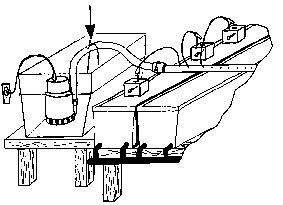
communicating vessels
In practice, it appears that high-pressure gas lamps give optimal results for 4 to 5 harvests. After those, it’s advisable to replace them. It seems that the installation of one 600 Watt sodium lamp per square meter is enough to achieve the best results. Principally one can say ‘the more light, the better’, but with more illumination, the control of other factors (namely, temperature control) becomes a problem. Indoor growers work with their light source close to the plants. Considering the light yield of the sun, (hundreds of thousands of lumens, but a little further away), fewer lumens are needed for growing indoors. A simple formula shows that you can also use three 400 W lamps for two square meters. The sodium lamps provide light from the red spectrum. This light is used principally during growth. A mercury-iodide lamp fills in the blue spectrum. For reflection, growers use wide-angle reflectors with sodium lamps, and super-wide-angle reflectors with mercury-iodide lamps. Super-wide-angle reflectors spread the light over a greater surface area. We use the proportions of 3 red lights to 1 blue. So, the light from the blue lamp must be spread over a larger surface area.
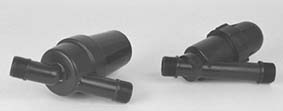
PE filters
4.3. Using high-pressure gas lamps
High-pressure gas lamps may only be used in the fitting meant for that particular lamp type. High-pressure gas lamps all have their own start-up conditions, voltages, characteristics, and shapes. Using lamps with improper sockets can cause electrical shorts! Therefore, it’s recommended that you buy all the parts of a pressurized gas lamp from the same dis- tributor. The sockets, ballasts, and connectors must always be protected from humidity; otherwise, electrical shorts occur. As stated earlier, high-pressure gas lamps have a long life span. You must be careful when replacing these lamps. They are, as the name implies, under pressure, and they explode when you destroy them. When you do that yourself, you must always wear gloves and safety glasses. In addition, you have to protect yourself against the poisonous materials found in these kinds of lamps. The heat given off by high-pressure gas lamps, and their accompanying starter ballasts, must be completely ventilated. This means that the lamps shouldn’t hang too close to the plants (hence drying and burning occurs), but also not too close to (flammable) ceilings and walls. Place a piece of non-flammable material (not asbestos!) between the lamp and ceiling or wall. Furthermore t’s necessary to discharge of excess heat by using a ventilator. Finally, it’s important to keep high-pressure gas lamps clean. Dirty lamps provide much less light yield than clean ones. The lamps should be polished now and then with some glass- cleaning agent. That should be done only when the lamps are turned off, and well-cooled.
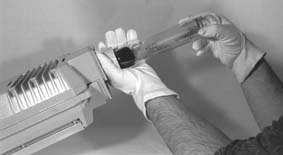
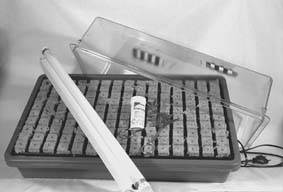
the use of gloves to protect the lightbulb cloning accessories
Be especially careful with water. Lamps which are still hot, or even warm, can explode when touched, and that’s not funny Also, take care never to touch these types of lamps with your fingers. Just like halogen lamps, bodily acids can burn through, causing the lamp to fly to pieces.
4.4. Proper lighting for cannabis
The advantage of growing cannabis indoors is the fact that you can give the plants the feeling that it’s their flowering season all year round. You’re not dependent on the weather or the season. We distinguish two separate phases in plant cultivation: the growth- or vegetative phase, and the flowering- or generative phase. We’ve already made sure the lamps are installed in such a way that all the plants can be optimally illuminated. A light period of 18 hours and a dark period of 6 hours is ideal for the vegetative phase. We’re assuming that you already have cuttings with roots. With proper care, a healthy cannabis plant can grow up to 5 centimeters per day. It’s very easy to cause the plant to flower. We only have to give the plants the idea that the days are getting shorter (‘autumn’; for cannabis, the sign to flower). We do that by making the light and the dark periods the same length; – 12 hours. In principle, cannabis is an annual plant. The entire life cycle, from seed to death, takes place in one year in nature. When growing cannabis under artificial light, it is possible to force flowering earlier than in nature. After 4 or 5 days vegetative phase, flowering can be ‘provoked’. We do that the moment the clones have visibly started to grow. Two or three weeks after the light period is reduced to 12 hours, the plants begin to flower. It’s very important not to interrupt the dark period. If the plants receive light during the 12-hour dark period, they ‘get confused’; they want to continue growing, and the blooming phase is postponed. The generative phase lasts 60 days or longer, depending on the variety you’re growing. When working with cuttings, it’s possible to harvest four to five times a year.
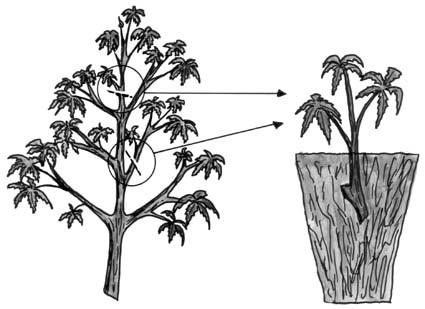
the cutting
Rockwool the Book Chapter #1
Learn how to grow medical marijuana hydroponicly,
all 8 chapters ONLINE!
Rockwool #2 Physiology of Plants
Rockwool #3 Necessities and Climate Control
Rockwool chapter #4 Lights
Rockwool #5 Lights,CO2,Climate,Humidity
Rockwool #6 Water
Rockwool #7 Growing Cannabis
Rockwool #8 Diseases, Pests,& Plagues
|



 Button Ads!
Button Ads! 